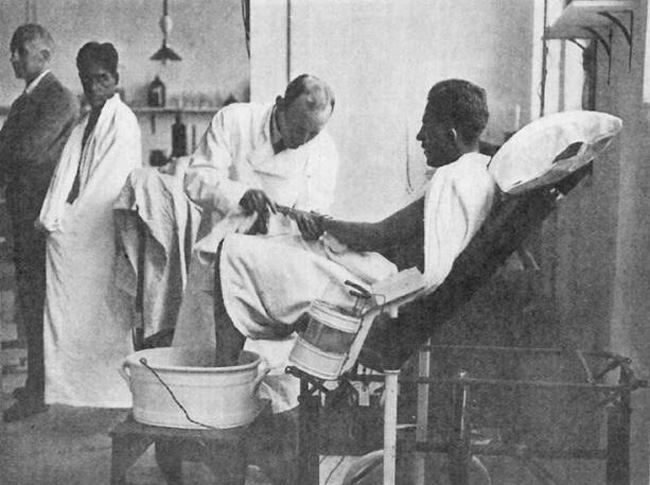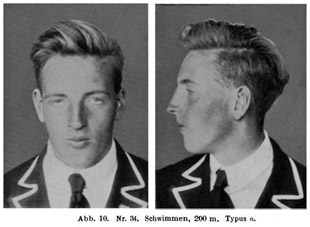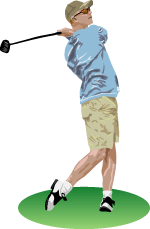A team lead by Professor Frederik Jakobus Johannes Buytendijk set up a laboratory for testing athletes at the 1928 Olympic Games. The investigations were divided into various groups: Anthropometry, Measurements of Force, General Clinical Examination, X-Ray Examination of the Joints, Examination of Heart and Circulation, Digestion, Blood. Secretion of Urine and Sweat. In terms of anthropometry, the researchers examined 300 athletes, recording age, height, weight and vital capacity. Body types were also studied, and a height/weight index calculated.
The results of the best 22 sprinters in the world had a mean weight of 64.5 kg (142.3 lbs) and 172.5cm (5' 7.9") height, which gave a mean weight/height index of 2.17. He found that the 400m runners were slightly taller (175.8cm / 5' 9.2") and heavier (65.2kg / 143.7 lbs) (see the changes in the anthropometry measurements of 100m sprinters throughout the Olympics).
 scientific research being conducted on athletes from the 1928 Olympic Games
scientific research being conducted on athletes from the 1928 Olympic Gamesfrom the frlom the official report of the 1928 Olympic Games
Publications
Research results were published in "Ergebnisse der sportärztlichen Untersuchungen bei den IX. Olympischen Spielen in Amsterdam 1928" (Results of the sports medical examinations at the IX Olympic Games in Amsterdam in 1928).
The results of the investigations by Professor Buytendijk and his team were published in a book which contained articles by Prof. KOHLRAUSCH (anthropometry), Prof. DYBOWSKI (anthropometry), Prof. BETHE (measurements of force), Prof. LATARJET, Dr. LAUGIER and Dr. FESSARD (reaction period; recovery after fatigue), Dr. HEISS (X-ray examination of joints), Dr. HERXHEIMER and Dr. DEUTSCH (X-ray 952 examination of the heart), Prof. BÜRGER (blood pressure measurements), Dr. HOOGERWERF electro-cardiography), Prof. BRAMWELL and Dr. ELLIS (heart and blood-pressure examination), Dr. MARX (digestion), Prof. HUNTEMÜLLER and Prof. THÖRNER (blood examination), Prof. SCHENK (urine examination) and Prof. SNAPPER (secretion of sweat).
 profile image of a swimmer
profile image of a swimmer from the book by Buytendijk, 1928
Related Pages
- Anthropometry at the Olympics
- Sport Specific Anthropometry
- Science and the Olympics
- Olympics Anthropology Days
- about the 1928 Amsterdam Olympics



